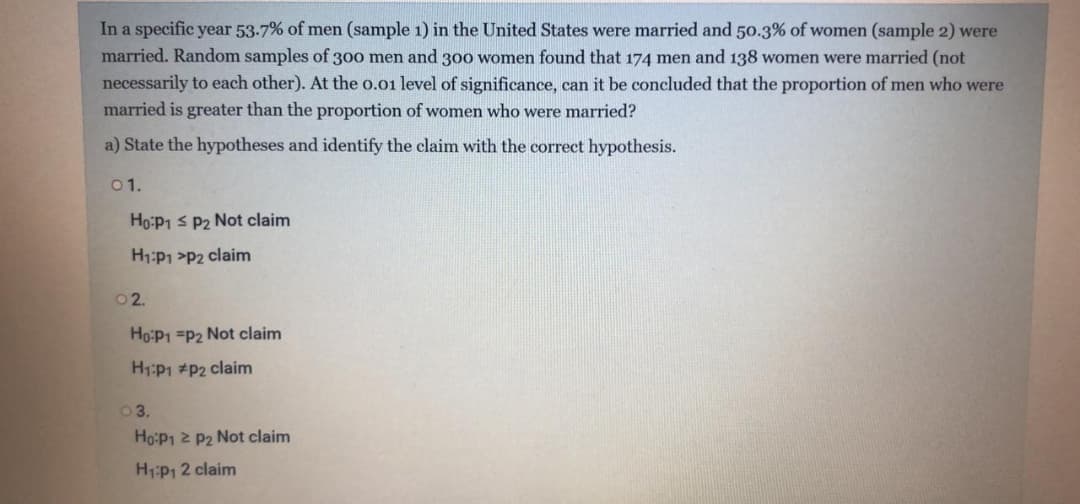In a specific year 53-7% of men (sample 1) in the United States were married and 50.3% of women (sample 2) were married. Random samples of 30o men and 300 women found that 174 men and 138 women were married (not necessarily to each other). At the o.01 level of significance, can it be concluded that the proportion of men who were married is greater than the proportion of women who were married? a) State the hypotheses and identify the claim with the correct hypothesis. 01. Ho:P1 s P2 Not claim H1:P1 >P2 claim 02. Ho P1 =P2 Not claim H1:P1 #P2 claim 03. Ho:P1 2 P2 Not claim H1:P1 2 claim
In a specific year 53-7% of men (sample 1) in the United States were married and 50.3% of women (sample 2) were married. Random samples of 30o men and 300 women found that 174 men and 138 women were married (not necessarily to each other). At the o.01 level of significance, can it be concluded that the proportion of men who were married is greater than the proportion of women who were married? a) State the hypotheses and identify the claim with the correct hypothesis. 01. Ho:P1 s P2 Not claim H1:P1 >P2 claim 02. Ho P1 =P2 Not claim H1:P1 #P2 claim 03. Ho:P1 2 P2 Not claim H1:P1 2 claim
Holt Mcdougal Larson Pre-algebra: Student Edition 2012
1st Edition
ISBN:9780547587776
Author:HOLT MCDOUGAL
Publisher:HOLT MCDOUGAL
Chapter11: Data Analysis And Probability
Section: Chapter Questions
Problem 8CR
Related questions
Question

Transcribed Image Text:In a specific year 53-7% of men (sample 1) in the United States were married and 50.3% of women (sample 2) were
married. Random samples of 300 men and 30o women found that 174 men and 138 women were married (not
necessarily to each other). At the 0.01 level of significance, can it be concluded that the proportion of men who were
married is greater than the proportion of women who were married?
a) State the hypotheses and identify the claim with the correct hypothesis.
01.
Ho:P1 s P2 Not claim
H1:P1 >P2 claim
02.
Ho:P1 =P2 Not claim
H1:P1 #P2 claim
03.
Ho:P1 2 P2 Not claim
H1:P1 2 claim
Expert Solution
This question has been solved!
Explore an expertly crafted, step-by-step solution for a thorough understanding of key concepts.
Step by step
Solved in 2 steps

Knowledge Booster
Learn more about
Need a deep-dive on the concept behind this application? Look no further. Learn more about this topic, statistics and related others by exploring similar questions and additional content below.Recommended textbooks for you

Holt Mcdougal Larson Pre-algebra: Student Edition…
Algebra
ISBN:
9780547587776
Author:
HOLT MCDOUGAL
Publisher:
HOLT MCDOUGAL

Holt Mcdougal Larson Pre-algebra: Student Edition…
Algebra
ISBN:
9780547587776
Author:
HOLT MCDOUGAL
Publisher:
HOLT MCDOUGAL